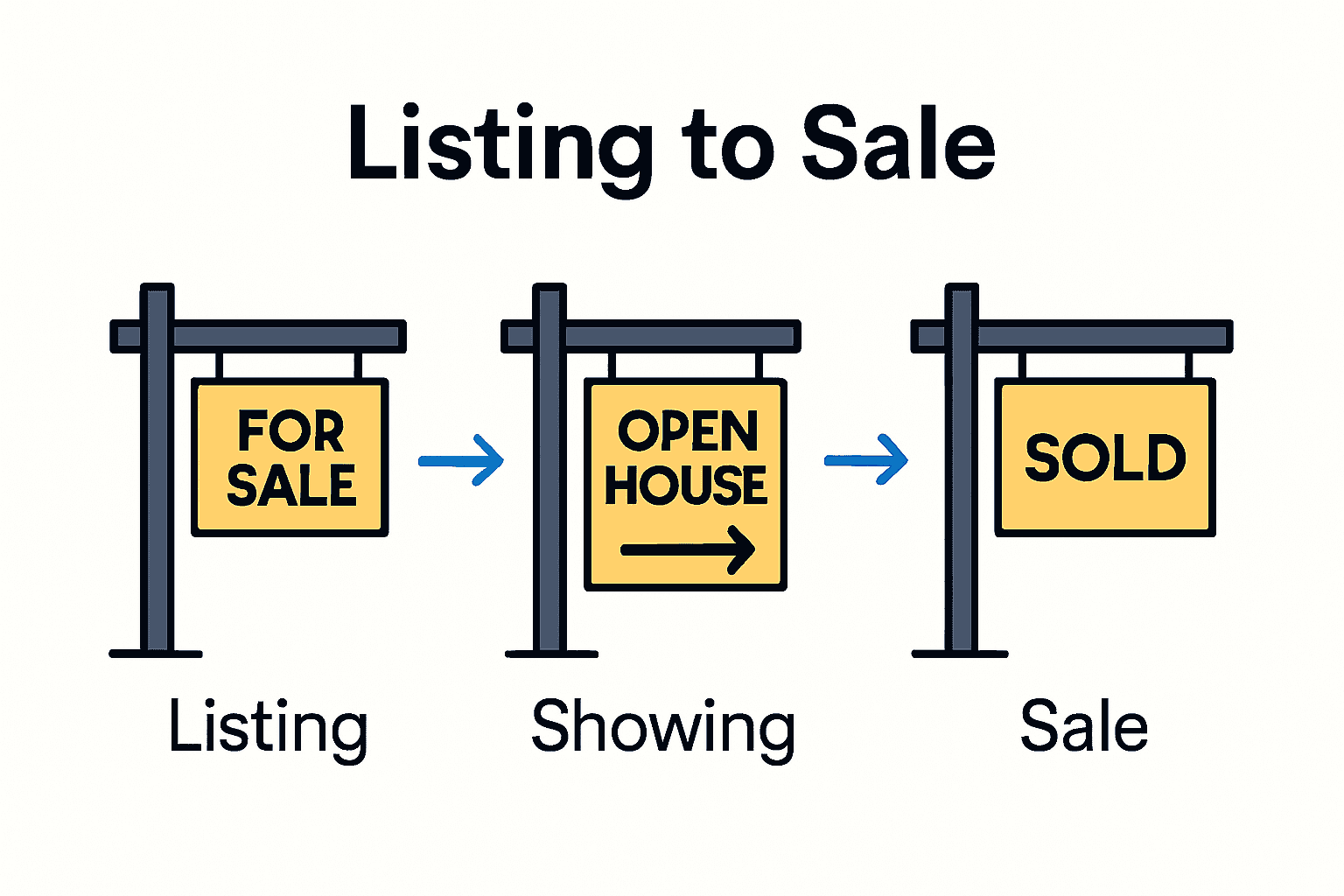{
“@type”: “Article”,
“author”: {
“url”: “https://customsignstoday.us”,
“name”: “Customsignstoday”,
“@type”: “Organization”
},
“@context”: “https://schema.org”,
“headline”: “Why Use Real Estate Signs: Complete Expert Guide”,
“language”: “en”,
“publisher”: {
“url”: “https://customsignstoday.us”,
“name”: “Customsignstoday”,
“@type”: “Organization”
},
“articleBody”: “Why use real estate signs? This comprehensive guide covers benefits, types, design tips, legal rules, and best practices for effective real estate marketing.”,
“description”: “Why use real estate signs? This comprehensive guide covers benefits, types, design tips, legal rules, and best practices for effective real estate marketing.”,
“datePublished”: “2025-11-07T03:00:15.119Z”
}
Over ninety percent of home buyers say they discovered properties thanks to a real estate sign they spotted while driving or walking. These eye-catching displays do more than advertise a home for sale. They shape first impressions, provide crucial information at a glance, and help neighborhoods present a welcoming face to everyone searching for a new place to live. Understanding the true function and subtle impact of real estate signs can reveal new ways to attract attention and maximize your property’s appeal.
Table of Contents
- Defining Real Estate Signs And Their Purpose
- Types Of Real Estate Signs And Their Uses
- How Real Estate Signs Drive Buyer Interest
- Design Strategies For Maximum Visibility
- Legal Guidelines And Best Practices For Signs
Key Takeaways
| Point | Details |
|---|---|
| Sign Purpose | Real estate signs serve as crucial communication tools that provide essential property information and support fair housing principles. |
| Types of Signs | Different sign types, including For Sale, Open House, and Sold, serve specific marketing purposes and require adherence to local regulations. |
| Buyer Engagement | Well-designed signs drive buyer interest by effectively conveying property details, enhancing visibility, and inviting engagement from potential buyers. |
| Legal Compliance | Understanding and following local sign regulations is essential for real estate professionals to ensure effectiveness while maintaining community standards. |
Defining Real Estate Signs and Their Purpose
Real estate signs are critical communication tools that serve multiple strategic purposes in property marketing and community information sharing. These visual markers provide essential details about available properties, helping potential buyers, renters, and local residents quickly understand key information about real estate opportunities. According to wra.org, real estate signs play a crucial role in supporting fair housing principles by creating a neutral marketing platform that invites individuals from all social and economic backgrounds to explore housing opportunities.
At their core, real estate signs function as dynamic informational billboards that communicate critical property details. They typically include fundamental information such as:
- Property status (For Sale, For Rent, Sold)
- Contact information for real estate agents
- Price point or rental rates
- Basic property specifications
- Open house or viewing schedules
Moreover, these signs serve broader community purposes beyond simple property advertising. As sanramon.ca.gov highlights, municipal sign ordinances aim to promote economic vitality while maintaining aesthetic standards. By regulating sign design, size, and placement, communities can ensure these markers enhance rather than detract from neighborhood appearances.
Real estate signs are not just marketing tools but sophisticated communication platforms that balance information sharing, legal compliance, and community aesthetic standards. Whether guiding potential buyers, supporting fair housing principles, or providing neighborhood context, these signs play a nuanced and essential role in property transactions and local real estate ecosystems. Explore our comprehensive guide on custom real estate signs to understand how strategic signage can elevate your property marketing approach.
Types of Real Estate Signs and Their Uses
Real estate signs represent a diverse ecosystem of visual communication tools, each designed to serve specific marketing and informational purposes within the property landscape. According to scottsdaleaz.gov, these signs can be categorized into distinct types, such as on-premise post-and-panel signs for immediate property details and off-premise traffic directional signs guiding potential buyers to residential activities.
The primary categories of real estate signs include:
Here’s a comparison of common real estate sign types and their typical uses:
| Sign Type | Main Purpose | Typical Placement |
|---|---|---|
| For Sale | Advertise property availability | Front yard of property |
| Open House | Direct buyers to property showings | Street corners Near property |
| Sold | Indicate completed transactions | On sold property |
| Pending Sale | Show property is under contract | On property yard |
| Rental | Highlight leasing opportunities | Residential/commercial property |
- For Sale Signs: Standard markers indicating property availability
- Open House Signs: Temporary directional indicators for property viewings
- Sold Signs: Confirmation of completed property transactions
- Pending Sale Signs: Indicating properties under contract
- Rental Signs: Highlighting available leasing opportunities
As ocrealtors.org highlights, each sign type comes with specific size and placement regulations to maintain community aesthetics and ensure public safety.
 These regulations help balance marketing needs with neighborhood visual harmony, preventing sign clutter and potential traffic distractions.
These regulations help balance marketing needs with neighborhood visual harmony, preventing sign clutter and potential traffic distractions.
Beyond basic property status communication, specialized real estate signs can serve nuanced purposes like neighborhood branding, community development indicators, and targeted marketing strategies. Explore our comprehensive guide on 7 key real estate sign examples to understand how strategic signage can transform property marketing approaches and create meaningful connections with potential buyers.
How Real Estate Signs Drive Buyer Interest
Real estate signs are powerful psychological triggers that transform passive property browsing into active buyer engagement. According to wra.org, these signs play a critical role in creating nondiscriminatory access to housing by inviting individuals from all backgrounds to explore potential property opportunities, thereby democratizing the real estate discovery process.
The mechanisms through which real estate signs generate buyer interest are multifaceted:
- Immediate Visual Communication: Quickly convey property availability
- Location-Based Marketing: Target potential buyers in specific neighborhoods
- Social Proof: Signal active market interest and property desirability
- Contact Accessibility: Provide direct connection points for interested parties
- Curiosity Generation: Spark potential buyers’ imagination about property potential
As realestateinvesting.org notes, strategic sign placement represents a cost-effective method for generating leads and driving buyer interest. These signs act as silent salespeople, working around the clock to attract potential buyers by creating visual touchpoints that transform casual observers into serious property prospects.
Understanding the psychological impact of real estate signage can significantly enhance marketing strategies. Explore our comprehensive guide to creating impactful real estate signs to learn how thoughtful design and strategic placement can transform your property marketing approach and maximize buyer engagement.
Design Strategies for Maximum Visibility
Real estate signs require strategic design to capture potential buyers’ attention in increasingly competitive markets. As pref.northeastern.edu emphasizes, selecting the appropriate sign type and ensuring precise placement are critical components of maximizing visual impact and effectiveness.
Key design strategies for creating highly visible real estate signs include:
- High Contrast Color Schemes: Utilize bold, complementary colors that stand out
- Large, Readable Typography: Choose fonts that are legible from a distance
- Minimalist Information Design: Include only essential, compelling details
- Strategic Size Selection: Ensure signs are proportionate to viewing distance
- Weather-Resistant Materials: Maintain sign quality in diverse environmental conditions
According to realestateinvesting.org, effective sign design goes beyond aesthetics by crafting compelling messages and strategically positioning signs in high-traffic areas. The goal is to transform passive visual information into an active invitation for potential buyers to engage with the property.
Understanding the nuanced art of sign visibility can dramatically transform your real estate marketing approach. Explore our comprehensive guide on designing custom signs for visual branding to unlock advanced strategies that will make your real estate signs impossible to ignore.
Legal Guidelines and Best Practices for Signs
Real estate sign regulations are complex legal frameworks designed to balance marketing needs with community aesthetic and safety standards. As newportbeachca.gov demonstrates, municipalities establish specific guidelines that dictate everything from sign dimensions to placement restrictions.
Key legal considerations for real estate signs include:
- Size Limitations: Typically restricted to 1.5 square feet
- Height Restrictions: Usually maximum of 4 feet tall
- Placement Requirements: Must be on private property
- Duration Constraints: Specific timeframes for display
- Visibility Standards: Cannot obstruct traffic or public pathways
According to ocrealtors.org, real estate professionals must carefully navigate local ordinances to ensure compliance. These regulations are not just bureaucratic hurdles but essential mechanisms for maintaining community standards, protecting public safety, and ensuring fair marketing practices.
Understanding the legal landscape of real estate signage requires ongoing education and awareness. Explore our comprehensive guide to exterior signage basics to help you navigate the complex world of sign regulations while maximizing your marketing potential.
Elevate Your Property Marketing with Custom Real Estate Signs
Navigating the complex world of real estate signage can be challenging when you need to balance legal guidelines, design strategies, and buyer engagement. This expert guide highlights how effective real estate signs not only attract attention but also communicate crucial property information clearly and professionally while maintaining community standards. If you are looking to solve problems like ensuring sign visibility, complying with local regulations, or driving buyer interest, adopting custom-made signs tailored to your unique needs is essential.

Discover how our professional signage solutions at Uncategorized can help you create impactful real estate signs that stand out in busy neighborhoods. With our high-quality materials and customizable options, you get durable signs designed for maximum attention and compliance. Don’t wait for potential buyers to pass you by. Visit https://customsignstoday.us now to request your free quote and take the first step toward transforming your property marketing strategy with expert signage tailored just for you.
Frequently Asked Questions
What are the main purposes of real estate signs?
Real estate signs serve multiple purposes, including advertising property availability, providing contact information for agents, indicating property status, and conveying basic property specifications. They also help in supporting fair housing principles by inviting diverse individuals to explore housing opportunities.
What types of real estate signs are commonly used?
Common types of real estate signs include “For Sale” signs, “Open House” signs, “Sold” signs, “Pending Sale” signs, and rental signs. Each type has specific purposes and regulations regarding size and placement to ensure community aesthetics and safety.
How do real estate signs help drive buyer interest?
Real estate signs engage potential buyers by providing immediate visual communication about property availability, generating curiosity, and creating social proof of property desirability. They serve as cost-effective marketing tools that attract serious property prospects by establishing visual touchpoints.

What design strategies maximize the visibility of real estate signs?
To maximize visibility, real estate signs should utilize high contrast color schemes, large readable typography, and minimalist information designs. Employing weather-resistant materials and ensuring the sign is strategically placed in high-traffic areas can also enhance effectiveness.

